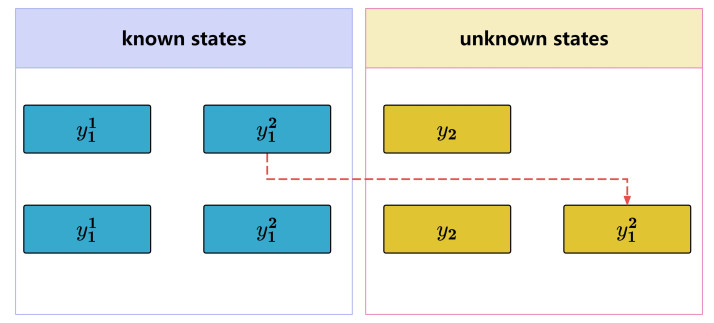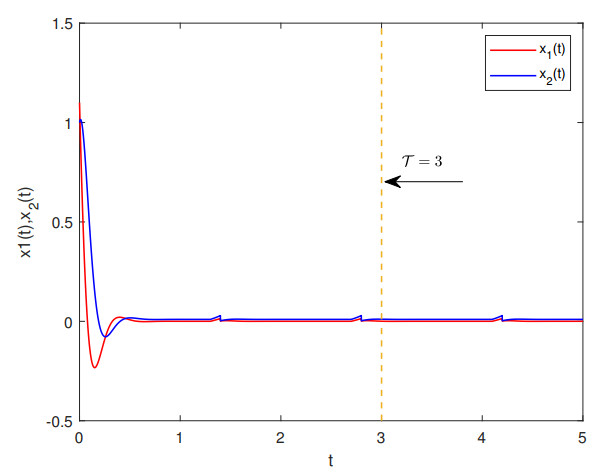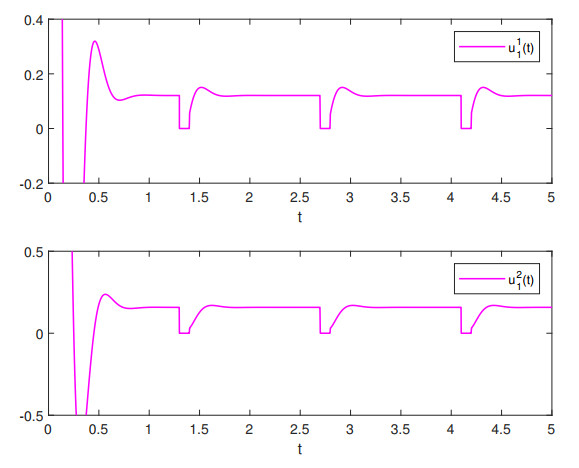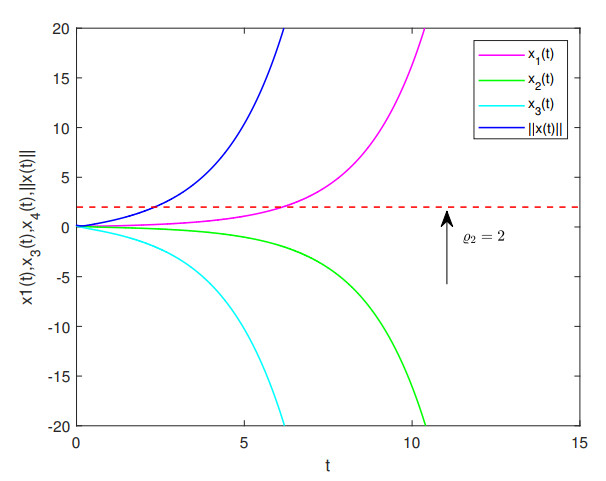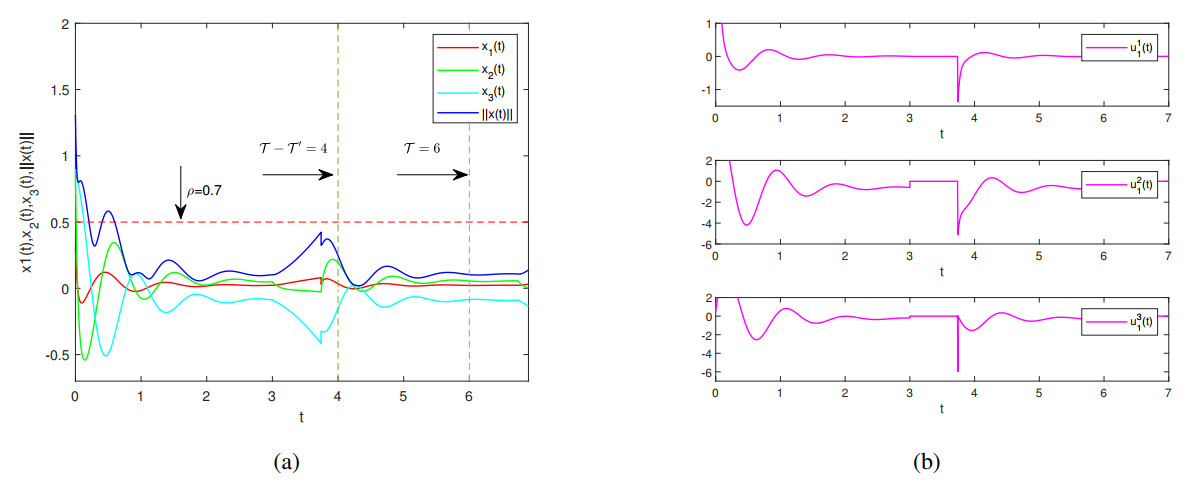1.
Introduction
In recent years, nonlinear systems have become a research hotspot in control theory due to their theoretical significance and practical applications in the synchronization of networked systems, digital signal processing, and stabilization of dynamical systems (see e.g., [1,2,3,4]). Among the many research directions of nonlinear systems, the problems of finite-time stabilization (FTS) and finite-time convergence stabilization (FTCS) have aroused widespread attention. FTS emphasizes that the system state will stabilize within a bounded region that is larger than the range of the initial state in a finite time (see e.g., [5,6,7,8]), while FTCS further emphasizes that the system state can converge to a bounded region smaller than the initial state range within a specified time (see e.g., [9,10,11]).
In engineering practice, control signals are crucial for maintaining the desired state of complex systems. Traditionally, continuous control strategies have been predominantly employed. However, as an innovative discontinuous control strategy, intermittent control (IC) offers significant advantages over continuous strategies. IC divides the time between two adjacent control signals into a "control interval" (operation) and a "rest interval" (no operation), thereby reducing redundant and unnecessary control actions and extending the lifespan of the equipment. Depending on whether the control signal is applied at fixed time intervals, IC can be classified into periodic intermittent control (PIC) (see e.g., [12,13]) and aperiodic intermittent control (APIC) (see e.g., [14,15,16,17,18,19]). In [13], the Halanay inequality and PIC were used to handle differential inequalities, thus successfully achieving the stability of highly nonlinear stochastic coupled systems. The theoretical results not only encompassed previous findings, but also provided theoretical support for the design and analysis in the field of nonlinear stochastic systems. However, the fact that the control signals in PIC are predefined and unchangeable restricts its flexibility for different applications. Therefore, a more flexible APIC is proposed, which adjusts the starting time sequence and control width to achieve a more efficient control. In [17], the input-to-state stability (ISS) of semi-linear systems was achieved through APIC, and the results indicated that the width of the control interval has a positive impact on the ISS of the system. In [19], further research on APIC led to the following conclusions: PIC and time-triggered APIC both belong to strong control schemes and achieve system stability more quickly than event-triggered APIC. However, event-triggered IC outperforms time-triggered IC in terms of the control number, control cost, and control rate. From the studies reported above, it is clear that APIC is a very powerful control tool.
In addition, impulsive control (IMC) is a discontinuous control method with extensive applications across diverse sectors including communication systems, automation, and aerospace (see e.g., [20,21,22,23,24]). Its main characteristic is the use of short-duration, high-intensity control inputs at specific discontinuous moments to regulate the system behavior. Traditional impulse sequences (IMS) are typically preset and essentially act as a time-triggered mechanism. However, unnecessary impulsive actions may occur during information transmission, thus resulting in a low control performance. Recently, event-triggered impulsive control (ETIMC) has emerged as a new research approach that combines event-triggered control (ETC) with IMC (see e.g., [25,26,27]). ETC is a mechanism that triggers control actions based on changes in the system state, rather than relying on fixed time intervals. In this way, the IMS in ETIMC is dynamically determined by an event-triggered mechanism (ETM), which closely links IMC to the system state. In [28], three event-triggered conditions were designed to achieve synchronization in chaotic dynamical systems. Similarly, in [29], a novel switching ETIMC was proposed, and an appropriate Lyapunov function was constructed to achieve quasi-synchronization in memristive neural networks with communication delays. Furthermore, in [30], a distributed ETIMC method was developed and was used to investigate the leader-following consensus problem in multi-agent systems. These control methods not only achieve a state consensus, but also effectively reduce the resource consumption.
It should be noted that a obtaining a complete system state in practical applications is often challenging due to external disturbances and technical limitations. Therefore, the design and implementation of control strategies based on the system state must fully take these practical difficulties into account. To address situations where only partially states is available, in [31], the problem of synchronization of neural networks with unmeasurable states was investigated using observers and state-feedback control to explore two scenarios: Unmeasurable states in the drive neural network and unmeasurable states in the response neural network. In [32], a dimensionality reduction technique was applied to separate known and unknown states, and the exponential stability of a switching system with partially unmeasurable states was achieved through a state feedback control. It is worth noting that the methodology to achieve FTS and FTCS in nonlinear systems with partially known states is still a complex problem and is insufficiently explored.
Based on the previous discussion, this paper proposes a novel hybrid control strategy that combines APIC and ETIMC to address the FTS and FTCS problems of nonlinear systems with partially known states. The key contributions of this paper are outlined below:
(i) In the case of mismatched dimensions between the known and unknown states, we discuss two scenarios. By using dimension extension techniques, the dimensions of the known and unknown states are made equal, thereby facilitating the effective application of the results.
(ii) We design a targeted impulsive control strategy that uses information from the known states to design impulsive control gains for the unknown states, thereby achieving state transitions at impulse moments and ensuring that the system meets the desired performance.
(iii) Within the framework of FTS and FTCS, a close relationship is established between the event-triggered parameters, the intermittent control width, and the boundary parameters, thus preventing the occurrence of Zeno-behavior and ensuring the effectiveness and feasibility of the novel hybrid control strategy.
The paper is structured as follows: Section 2 introduces some necessary prerequisites; Section 3 focuses on several key conclusions and presents some critical conditions to support the FTS and the FTCS; Section 4 verifies the proposed conclusions using two simulation examples; and finally, Section 5 concludes the paper by summarizing the main content.
Notations: Let R and N signify the sets of real numbers and natural numbers, respectively. Rn and Rn×m denote the n-dimensional real space and the n×m-dimensional real space, respectively. λmax(A) and λmin(A) represent the maximum and minimum eigenvalues of matrix A, respectively. A>0 (or A<0) denotes that A is a symmetric positive definite (or negative definite) matrix. I and O denote the identity matrix and the zero matrix of appropriate dimensions, respectively. ⋆ denotes the symmetric block of a symmetric matrix. PC([−τ,0],Rn) denotes the set of right-continuous piecewise functions ϕ:[−τ,0]→Rn with the norm defined as ‖ϕ‖τ=sup−τ≤s≤0‖ϕ(s)‖. C(S,L) denotes the family of continuous functions ϑ:S→L. For ϑ(t)∈C(S,L), D+ϑ denotes the upper right-hand Dini derivative: D+ϑ(t)=lim△→0+(sup(ϑ(t+△)−ϑ(t)))/△.
2.
Model description and preliminaries
Consider the following nonlinear time-delay system:
where x(t)∈Rn denotes the system state, and ˙x(t) denotes the right-hand derivative of x(t). τ is time delay, which is constant, and ψ∈PC[(−τ,0),Rn]. A and B ∈Rn×n are system matrices. The function F(x)=(f1(x1),f2(x2),⋯,fn(xn))T:Rn→Rn, fi(0)=0, and positive constant li meets
C∈Rn×r is the coefficient matrix, and u(t) is APIC, which is characterized as follows:
where Z∈Rr×n is the gain matrix of APIC, {tk:k∈N+}={tk} is the IMS, as determined by the ETIMC devised later, and δk represents the control width of the APIC, which satisfies the relation 0<δk<tk+1−tk. It is worth noting that controller (2.2) only carries out the input of the control signals in the control interval.
Upon introducing APIC (2.2) into system (2.1), one obtains the following:
where K=CZ.
Disturbances in the external environment, limitations in measurement techniques, and the complexity of the system structure make it possible that the states of a nonlinear system may not be completely known. In view of this, assume that system (2.3) has m known states, where 0<m<n. Let Ω1={ȷ1,ȷ2,…,ȷm} and Ω2={ȷm+1,ȷm+2,…,ȷn} denote the set of subscripts of the known states and the set of subscripts of the unknown states, respectively. By a transition matrix J to make y=Jx=(xȷ1,xȷ2,…,xȷn)T, then system (2.3) is transformed into the following:
where Ay=JAJ−1, Ky=JKJ−1, By=JBJ−1, ψy=Jψ, y=(y1,y2)T, and y1∈Rm and y2∈Rn−m represent the portions that correspond to the known states and unknown states, respectively.
Remark 2.1. In recent years, hybrid control methods that combine APIC and ETIMC have been explored in [25,26,27,28,29,30]. However, these methods presuppose that the state information of the system is completely known. As a result, these aforementioned methods become inapplicable when only the partial state information is available. In this paper, we integrate APIC with ETIMC to study the FTS and FTCS of system (2.4), thereby extending the existing results. Specifically, we address two scenarios: one where the number of known states is greater than or equal to the number of unknown states, and the other where the number of known states is less than the number of unknown states.
Definition 2.1. [9] For the given positive constants T, ϱ1, and ϱ2, where 0<ϱ1<ϱ2, system (2.4) is said to be FTS with respect to (w.r.t.) (T,ϱ1,ϱ2) if there exists a controller such that, given ||y(0)||≤ϱ1, the trajectory of system (2.4) satisfies ||y(t)||≤ϱ2 for all t∈[0,T]. Moreover, under the above conditions, if there exist positive constants T0 and ϱ such that 0<T0<T and 0<ϱ<ϱ1<ϱ2, and the trajectory of system (2.4) satisfies ||y(t)||≤ϱ for t∈[T−T0,T], then system (2.4) is said to be FTCS w.r.t. (T,ϱ1,ϱ2,ϱ,T0).
Remark 2.2. According to [9,25], FTS describes the "boundedness" of a system whose state is stabilized in a bounded region that is larger than the initial state range for a finite period of time. In contrast, FTCS emphasizes that the system trajectory must remain within a smaller region than the initial boundary for a defined period time. In other words, FTCS not only reflects the "boundedness" of the system, but also demonstrates the "contraction" of the system.
Lemma 2.1. [33] For t∈(−τ,+∞), if the continuous function y≥0 meets
then
Lemma 2.2. [34] For any real matrices G>0 and scalar ι>0, the following relevant inequality holds:
Lemma 2.3. [35] For a given symmetric matrix M=[M11M12MT12M22], where M11∈Rs×s, the following three conditions are equivalent:
(i) M<0,
(ii) M22<0,M11−M12M−122MT12<0,
(iii) M11<0,M22−MT12M−111M12<0.
3.
Main results
Since there are partially unknown states in system (2.4), the designed ETM can only rely on the partially known states. Based on this, the corresponding ETM design scheme is proposed:
the forced impulse sequence (FIMS) {t⋄k} satisfies
and the event-triggered function
where V1(t) denotes the Lyapunov function, which depends on the known state y1. Δ stands for the forced impulse interval, which is usually set to a sufficiently large constant. ak>0 represents the parameters of the ETM.
Remark 3.1. Zeno-behavior occurs when the designed trigger condition is continuously satisfied. To prevent Zeno-behavior, a uniform positive lower bound should be set for the impulse intervals (see e.g., [25,36,37]). Combining (2.2) and (3.2), it follows that 0<δk<tk+1−tk≤Δ. Let δ=infk∈N{δk}; then 0<δ<tk+1−tk≤Δ, thereby excluding Zeno-behavior in the ETIMC.
Remark 3.2. Figure 1 shows the cyclic process of hybrid control, where dashed and solid lines represent discrete and continuous signals in the system, respectively. The ETM is used to detect whether predefined events occur. When ℵk≥0, the predefined event occurs, and the system receives the transmission value y(t−k). After calculation by the impulsive generator, y(t+k) is transmitted to the system. At this point, the system will enter the next cycle in accordance with the revised data conditions. When ℵk<0, the predefined event does not occur, and no signal is transmitted to the system. Figure 2 presents the framework of hybrid control, which introduces forced impulse instants on top of traditional impulse signal release, aiming to prevent the ETM from remaining inactive for an extended period, thus ensuring the system meets the desired performance objectives.
Next, we will discuss the FTS and FTCS in system (2.4) under a hybrid control in two cases based on the quantitative relationship between the known and unknown states.
3.1. The number of known states is greater than or equal to the number of unknown states
When m≥n−m, let y=(y1,y2)T, where y1=(y11,y21)T, y11=(xȷ1,xȷ2,⋯,xȷn−m)T∈Rn−m, y21=(xȷn−m+1,xȷn−m+2,⋯,xȷm)T∈R2m−n, y2=(xȷm+1,xȷm+2,⋯,xȷn)T∈Rn−m. F=(F1,F2)T, where F1=(F11,F21)T, F11=(f(xȷ1),f(xȷ2),⋯,f(xȷn−m))T∈Rn−m, F21=(f(xȷn−m+1),f(xȷn−m+2),⋯,f(xȷm))T∈R2m−n, F2=(f(xȷm+1),f(xȷm+2),⋯,f(xȷn))T∈Rn−m. Then, system (2.4) is given as follows:
where y11,y21∈y1, y1 is the known state, and y2 is the unknown state.
For m>n−m, as shown in Figure 3, we construct an augmentation term to make the number of known states equal to the number of unknown states. Let ˉy=(ˉy1,ˉy2)T, ˉy1=y1=(y11,y21)T, ˉy2=(y2,y21)T, ˉF=(ˉF1,ˉF2)T, ˉF1=F1, and ˉF2=(F2,F21)T. ˉy1 and ˉy2 represent the known and unknown parts of the states, respectively, and both have the same dimension. For m=n−m, system (3.3) does not perform a dimensional expansion and directly obtains ˉy1=y1, ˉy2=y2, ˉF1=F1, and ˉF2=F2. Hence, system (3.3) with ETIMC is updated as follows:
where
Remark 3.3. Unlike traditional impulsive controllers, which assume that all the system states are known, our design relies only on the partially known states at the impulsive moments. In other words, the impulsive jumps of the unknown states ˉy2 are adjusted based on the known states ˉy1.
Therefore, the analysis of the FTS and FTCS problems for system (2.1) is transformed into the analysis of the FTS and FTCS for system (3.4). For system (3.4), the IMS {tk} is dynamically determined by ETM (3.1), where V1(t)=ˉy1T(t)P1ˉy1(t), and P1∈Rm×m is a positive definite matrix. In the following, we will show that system (3.4) is the FTS and FTCS.
Theorem 3.1. Suppose there exist m×m real matrices P1>0, P2>0, 2m×2m real diagonal matrices Q, M, m×m real matrices S1, S2, and positive constants α1, α2, β1, β2, ξ1, ξ2, T>T0>0, ϱ2>ϱ1>ϱ>0, and ℏ>1, satisfying the following:
(I1) (HˉA+ˉATH−α1H−N−NTHˉB⋆−Q)≤0,
(I2) (HˉA+ˉATH−α2HHˉB⋆−M)≤0,
(I3) (−ℏP1S1S2⋆−P10⋆⋆−P2)≤0,
(I4) ξ1I≤H≤ξ2I,
(I5) N(0,t)lnℏ+N(0,t)∑i=0ai+(α2+β2)tN(0,t)+1−(α2+β2−(α1+β1))N(0,t)∑i=0δi≤ln(ξ1ϱ22)−ln(ξ2ϱ21),
where H=(P1+P2−P2−P2P2), L=diag{lȷ1,⋯,lȷn,lȷn−m+1,⋯,lȷm}, β1=λmax(LQLH−1), β2=λmax(LMLH−1). Then, system (3.4) is FTS w.r.t (T,ϱ1,ϱ2) under a hybrid control. Furthermore, if t∈[T−T0,T], and
(I6) N(0,t)lnℏ+N(0,t)∑i=0ai+(α2+β2)tN(0,t)+1−(α2+β2−(α1+β1))N(0,t)∑i=0δi≤ln(ξ1ϱ2)−ln(ξ2ϱ21)
holds, then system (3.4) is FTCS w.r.t (T,ϱ1,ϱ2,ϱ,T0) under a hybrid control. Besides, N(0,t) delegates the number of control periods on [0,T], T≠tk. The IMC gain matrices G1 and G2 are given by G1=P−11ST1, G2=P−11ST1+P−12ST2, and the APIC gain matrix is given by ˉK=H−1N.
Proof. For the given 0≤‖y(0)‖≤ϱ1, let y(t)=y(t,0,ψ) be the solution of system (3.4) through (0,ψ). Construct a Lyapunoov function as follows:
where V1=ˉy1T(t)P1ˉy1(t), V2=ˉy2(t)−ˉy1(t))TP2(ˉy2(t)−ˉy1(t)).
For t∈[tk,tk+δk),k∈N, one obtains the following:
where β1=λmax(LQLH−1), N=HˉK. From Lemma 2.1, one has the following:
When t∈[tk+δk,tk+1), k∈N, the following holds:
where β2=λmax(LMLH−1). From Lemma 2.1, one obtains the following:
Moreover, when t=tk,k∈N+, the following holds:
In fact, when t∈[0,δ0), from (3.7), one obtains the following:
Therefore,
For t∈[δ0,t1), combining (3.1) and (3.12), the following holds:
and
Next, we will claim that
For t∈[t1,t1+δ1), combining (3.7), (3.10), and (3.14), one has the following:
and
For t∈[t1+δ1,t2), combining (3.9) and (3.17), yields the following:
and
Thus, (3.15) holds for k=1. Assume that (3.15) holds for k=l. When t∈[tl,tl+1), it holds that
Then, we will show that (3.15) holds for k=l+1. From (3.20), we have the following:
Therefore, when t∈[tl+1,tl+1+δl+1), we derive
and
For t∈[tl+1+δl+1,tl+2), combining (3.9) and (3.23), one obtains the following:
This is, (3.15) is satisfied for k=l+1. Therefore, (3.15) holds for all k∈N(0,t). It holds that
By (I4) and (I5), we can easily obtain the following:
which signifies ‖y(t)‖≤ϱ2; thus, ‖y(t)‖≤ϱ2 holds on [0,T]. Therefore, system (3.4) is FTS, meaning that system (2.1) can achieve FTS under a hybrid control. When t∈[T−T0,T], if (I5) is satisfied, then from (3.25), we have the following:
which shows that ‖y(t)‖≤ϱ, for all t∈[T−T0,T]. Therefore, system (3.4) is the FTCS, that is, system (2.1) can achieve FTCS under a hybrid control. □
3.2. The number of known states is less than the number of unknown states
When m<n−m, let y=(y1,y2)T, where y1=(xȷ1,xȷ2,⋯,xȷm)T∈Rm, y2=(y12,y22)T, y12=(xȷm+1,xȷm+2,⋯,xȷ2m)T∈Rm, y22=(xȷ2m+1,xȷ2m+2,⋯,xȷn)T∈Rn−2m. F=(F1,F2)T, where F1=(f(xȷ1),f(xȷ2),⋯,f(xȷm))T∈Rm, F2=(F12,F22)T, F12=(f(xȷm+1),f(xȷm+2),⋯,f(xȷ2m))T∈Rm, F22=(f(xȷ2m+1),f(xȷ2m+2),⋯,f(xȷn))T∈Rn−2m. Then, system (2.4) is given as follows:
where y1 is the known state, y12,y22∈y2, and y2 is the unknown state. For m<n−m, as shown in Figure 4, we construct an augmentation term to make the number of known states equal to the number of unknown states. Expending the dimension of y1 with xȷm, it leads to ˜y1=(y1,ˆy)T, ˜F1=(F1,ˆF)T, where ˆy=(xȷm,xȷm,⋯,xȷm)T∈Rn−2m, and ˆF=(f(xȷm),f(xȷm),⋯,f(xȷm))T∈Rn−2m. Let ˜y=(˜y1,˜y2)T, ˜y1=(y1,ˆy)T, ˜y2=y2, ˜F=(˜F1,˜F2)T, ˜F1=(F1,ˆF)T, and ˜F2=F2. ˜y1 and ˜y2 denote the known and unknown parts of the states, respectively, with the same dimension. System (3.28) with ETIMC is updated as follows:
where
Therefore, the analysis of the FTS and FTCS problems for system (2.1) is transformed into the analysis of the FTS and FTCS for system (3.29). For system (3.29), the IMS {tk} is dynamically determined by ETM (3.1). For ETM (3.1), take V1(t)=˜y1T(t)P1˜y1(t), and P1∈R(n−m)×(n−m) is a positive definite matrix. In the following, we will show that system (3.29) is the FTS and FTCS.
Theorem 3.2. Suppose there exist (n−m)×(n−m) real symmetric matrices P1>0, P2>0, 2(n−m)×2(n−m) real diagonal matrices Q, M, (n−m)×(n−m) real matrices S1, S2, and positive constants α1, α2, β1, β2, ξ1, ξ2, T>T0>0, ϱ2>ϱ1>ϱ>0, and ℏ>1, satisfying the following:
(I7) (H˜A+˜ATH−α1H−N−NTH˜B⋆−Q)≤0,
(I8) (H˜A+˜ATH−α2HH˜B⋆−M)≤0,
(I9) (−ℏP1S1S2⋆−P10⋆⋆−P2)≤0,
(I10) ξ1I≤H≤ξ2I,
(I11) N(0,t)lnℏ+N(0,t)∑i=0ai+(α2+β2)tN(0,t)+1−(α2+β2−(α1+β1))N(0,t)∑i=0δi≤ln(ξ1ϱ22)−ln(ξ2ϱ21),
where H=(P1+P2−P2−P2P2), L=diag{lȷ1,⋯,lȷm,⋯,lȷm,lȷm+1,⋯,lȷn}, β1=λmax(LQLH−1), β2=λmax(LMLH−1). Then, system (3.29) is FTS w.r.t (T,ϱ1,ϱ2) under a hybrid control. Furthermore, if t∈[T−T0,T], and
(I12) N(0,t)lnℏ+N(0,t)∑i=0ai+(α2+β2)tN(0,t)+1−(α2+β2−(α1+β1))N(0,t)∑i=0δi≤ln(ξ1ϱ2)−ln(ξ2ϱ21)
holds, then system (3.29) is FTCS w.r.t (T,ϱ1,ϱ2,ϱ,T0) under a hybrid control. Besides, N(0,t) delegates the number of control periods on [0,T], T≠tk. The IMC gain matrices G1 and G2 are given by G1=P−11ST1, G2=P−11ST1+P−12ST2, and the APIC gain matrix is given by ˜K=H−1N.
Proof. The proof process of Theorem 3.3 follows similarly to that of Theorem 3.1, which is omitted here. □
Remark 3.4. The conditions (I5), (I6), (I11), and (I12) in Theorems 3.1 and 3.2 reveal the intricate interplay between the control interval width, the event-triggered parameter, and the boundary parameters. The results indicate that as the event-triggered parameter increases, the corresponding value of the IMS also increases, which can lead to the failure of the ETM. As a result, the IMS is entirely composed of the FIMS, thus preventing the system from reaching FTS and FTCS under the given conditions. Additionally, the values of α2 and β2 must increase as the event-triggered parameter and impulse sequence values increase to ensure that conditions (I5), (I6), (I11), and (I12) hold.
4.
Numerical examples
To demonstrate the validity of the hybrid control method, two numerical examples are provided.
Example 4.1. For system (2.1), where function f(xi)=0.3(|0.85xi(t−τ)+2|−|0.85xi(t−τ)−2|),i=1,2, τ=0.5 and
Now, consider system (2.1), where x2 is a known state, while x1 is unknown state. A transition matrix J can be constructed such that the transformed states are expressed as y1=x2,y2=x1. The transition matrix J, along with the transformed system matrices Ay and By, are given by the following:
Let y(0)=[1,1]T, and the parameters be ϱ1=1.3, ϱ2=2, T=3. Based on the trajectories of system (2.1), as shown in Figure 5, system (2.1) is not FTS w.r.t. (3, 1.3, 2) without hybrid control.
Since m=n−m=1, there is no need to construct an augmentation term. Therefore, under the hybrid control, system (2.1) is given as follows:
where ˉy1=y1 and ˉy2=y2 represent the known and unknown states, respectively. ˉF1=f(x2), ˉF2=f(x1), ˉA=Ay, and ˉB=By. Choose P1=2.4, P2=2.2, α1=1.5, α2=9.6, ℏ=1.04, ξ1=1, and ξ2=3.5. Under condititions (I1)–(I3) of Theorem 3.1, using the MATLAB toolbox, one can obtain the following:
Let ak=8, δk=1.3, and Δ=3; the ETM can be constructed by the following:
Therefore, the impulse instants are obtained as t1=1.3995, t2=2.7992, and t3=4.1989. Furthermore, for t∈[0,3], the IMS {tk} satisfies the following:
From Theorem 3.1, system (4.1) is FTS w.r.t (3, 1.3, 2) under the hybrid control strategy. For ˉy(0)=[1.1,1]T, the state trajectories of x1(t) and x2(t) are illustrated in Figure 6. Furthermore, let T0=1, ϱ=0.2; when t∈[T−T0,T], the IMS {tk} satisfies the following inequality:
Moreover, according to Theorem 3.1, system (4.1) is FTCS w.r.t (3, 1.3, 2, 0.2, 1) under the hybrid control strategy. Let ˉy(0)=[1.1,1]T. Figure 7 illustrates the trajectory of the norm ‖x(t)‖, while Figure 8 depicts the trajectories of u1.
Example 4.2. For system (2.1), where function f(xi)=0.3(|0.85xi(t−τ)+2|−|0.85xi(t−τ)−2|),i=1,2,3, τ=0.5 and
Now, consider system (2.1), where x3 is a known state, while x1 and x2 are unknown states. A transition matrix J can be constructed such that the transformed states are expressed as y1=xT3,y2=(x1,x2)T. The transition matrix J, along with the transformed system matrices Ay and By, are given by the following:
Let y(0)=[0.1,0.1,0.1]T, and the parameters be ϱ1=1.3, ϱ2=2, T=6. Based on the trajectories of system (2.1), as shown in Figure 9, system (2.1) is not FTS w.r.t. (6, 1.3, 2) without a hybrid control.
Since m<n−m, we construct an augmentation term of y1 using the known state x3. Therefore, under the hybrid control, system (2.1) is given as the following:
where ˜y1=(x3,x3)T and ˜y2=(x1,x2)T are the known states part and unknown states part, respectively. Additionally, ˜F1=(f(x3),f(x3))T, ˜F2=(f(x1),f(x2))T, and
Choose P1=diag{3,2.4}, P2=diag{2.37,2.2}, α1=9.4, α2=30, ℏ=1.1, ξ1=1, and ξ2=4. Under condititions (I7)−(I9) of Theorem 3.3, using the MATLAB toolbox, one can obtain the following:
Let ak=3.1, δk=3, and Δ=9; the ETM can be constructed by the following:
Therefore, the impulse instants are obtained as t1=3.7418, t2=7.5089. Furthermore, for t∈[0,6], the IMS {tk} satisfies the following:
By Theorem 3.3, system (4.3) is FTS w.r.t (6, 1.3, 2) under the hybrid control strategy. Moreover, take T0=2, ϱ=0.7; when t∈[T−T0,T], the IMS {tk} satisfies the following inequality:
Moreover, by Theorem 3.3, system (4.3) is FTCS w.r.t (6, 1.3, 2, 0.7, 2) under the hybrid control strategy. Let ˜y(0)=[0.3,0.9,0.9]T. Figure 10(a) illustrates the trajectories of x1(t), x2(t), and ‖x(t)‖ are depicted in Figure 10(a), while Figure 10(b) depicts the trajectories of u1.
5.
Conclusions
To address the limitation of traditional control methods that require the system state information to be completely known, this paper proposed a hybrid control strategy that combined IC and ETIMC to study the FTS and FTCS problems of nonlinear systems with partially known states. By employing impulsive differential inequalities and dimension extension techniques, impulsive control gains based on partially known states information were designed, and sufficient conditions to achieve FTS and FTCS were provided. Future research will focus on how to relax some restrictions in the theoretical criteria, thereby extending the applicability of the proposed method to a broader class of nonlinear systems.
Author contributions
Huiling Li: Writing-original draft; Jin-E Zhang: Supervision, writing-review and editing; Ailong Wu: Writing-review and editing. All authors have read and approved the final version of the manuscript for publication.
Use of Generative-AI tools declaration
The authors declare they have not used Artificial Intelligence (AI) tools in the creation of this paper.
Acknowledgments
This work is supported by the National Natural Science Foundation of China under Grant 62476082.
Conflict of interest
The authors declare that there are no conflicts of interest.
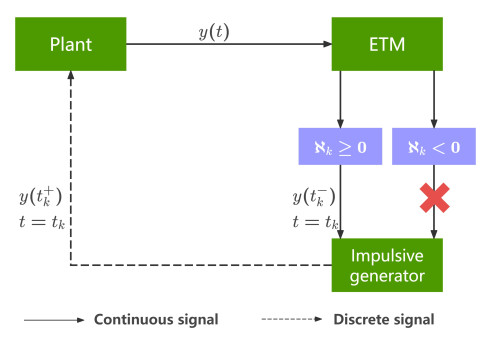









 DownLoad:
DownLoad:

